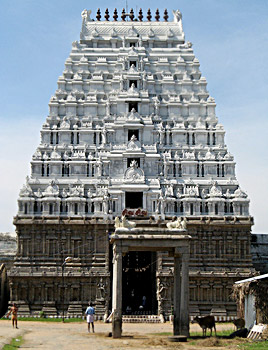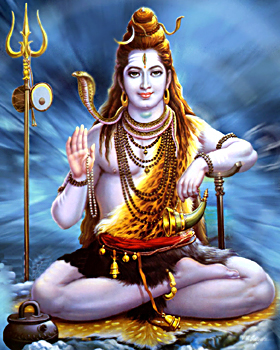 Land administration of temples followed certain set rules of governing temple lands as set by the authorities. Information regarding the administration of temples is obtained from the Tamil language inscriptions from Vijayanagar times which are inscribed on the walls of certain temples, such as, the walls of a Lord Shiva temple in Devikapuram in the North Arcot District, Tamil Nadu. Not only in these but also in the inscriptions of many other localities similar cases of the administration of temple land is found. Almost all these inscriptions talk about the lease of temple lands. Such abundance of evidence regarding the lease of temple lands leads to the conclusion that the lease system was probably of importance among the various systems of land tenure prevailing in the Vijayanagar Empire.
Land administration of temples followed certain set rules of governing temple lands as set by the authorities. Information regarding the administration of temples is obtained from the Tamil language inscriptions from Vijayanagar times which are inscribed on the walls of certain temples, such as, the walls of a Lord Shiva temple in Devikapuram in the North Arcot District, Tamil Nadu. Not only in these but also in the inscriptions of many other localities similar cases of the administration of temple land is found. Almost all these inscriptions talk about the lease of temple lands. Such abundance of evidence regarding the lease of temple lands leads to the conclusion that the lease system was probably of importance among the various systems of land tenure prevailing in the Vijayanagar Empire.
Temple Authorities
As for the authorities who leased out the temple land, there appear in inscriptions the names of several groups and individuals. Those groups are: Tanattar, Mahesvarar, Tanamahesvarar, Gurukkal and Kaikkolamudaligal. However, the interrelation of these groups is not known. These groups are treated as the representatives of the temples.
Lease-holders
Regarding leaseholders, it is seen that a number of them were Nayakas. It is concluded from the inscriptions that these Nayakas were sent from the Kannada country (the central region of the Empire) to be stationed there and govern this region. There is noticed a difference of grade among Nayakas in relation to the central power, which may suggest the relationship of sub-infeudation. Apart from the Nayakas, the temples were also taken by certain institutions, such as a Shiva temple, a Matha etc. In cases where the land was not leased out to Nayakas, the persons to whom they were given include: Manradi (shepherd), Vidvan (scholar) etc.
 Land Leased Out
Land Leased Out
In several cases, houses were also leased out along with the land. The nature of land is mostly defined as `Tangal.` This evidently means some class or type of land itself. The lands were both Punjey (dry) as well as Manjey (wet). The areas of the leased lands were in most cases between 500 and 1500 Kuli, the average being about 1000 Kuli.
Rights Given to Lease Holders
The right given to lease-holders was that of cultivation, and they were allowed to reclaim the lands by digging ponds and wells, and to plant whatever crops they wanted. The lease-holders, however, do not seem to have cultivated the lands themselves but apparently brought in cultivators to do the work. The lands were handed over as Kani. Kani generally means `right`. Kani is stated to be given with the eight kinds of right (Ashtabhogam) on land, which comprised the right of sale, transfer, exchange, etc. It will be understood, therefore, that the right granted was hereditary and well protected.
The receivers of the land were not the cultivators themselves, and the same is also to be inferred from the fact that many of the recipients were Nayakas or officers, who were not cultivators of the land they received. The expression `cultivators (Kudigal) who will come to reside` leads one to infer that these cultivators were not mere labourers hired for wages but people who had some rights over the land as tenants.
Payments to the Temple
The lease-holders probably sent to the temple treasury an amount of paddy or money or both, which was more or less equivalent to government taxes and enjoyed the rest of the produce, though they had to give some amount to the cultivators also. The amount which the lease-holder had to pay into the temple treasury is mentioned, with the enumeration of tax terms. Though it is not at all easy to understand the meanings of these tax terms, if closely examined, it is possible to tell what was to be paid to the temple by lease-holders and thus the substantial meaning of these leases can be understood.
Among the common taxes found are- Kadamai, Paiavari, Puduvari, Kanikkai, Kattayam and Mugamparvai. Since the fixed amount which is stipulated to be paid to the temple treasury is described as the payment in respect of these tax items, it seems that the temple collected from the lease-holders almost the whole of the taxes imposed on the land by the central government and also by some local authorities.



















